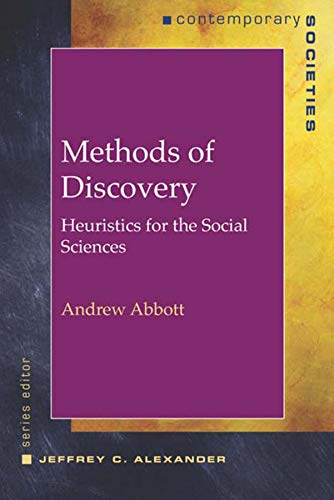Andrew Abbott: A Typology of Methods

The American sociologist and social theorist Andrew Abbott wrote a great book titled Methods of Discovery: Heuristics for the Social Sciences in 2004.

In Chapter 1, he developed a typology of methods with the following essential- questions (pp.13–26):
- How to propose a question?
- How to design a study?
- How to draw inferences?
- How to acquire and analyze data?
Each question could lead to a typology of methods. For example, if we pay attention to the type of data gathering, then we can find four basic social science methods:
- Ethnography: gathering data by personal interaction
- Survey: gathering data by submitting questionnaires to respondents or formally interviewing them
- Record-based analysis: gathering data from formal organizational records (censuses, accounts, publications, and so on)
- History: using old records, surveys, and even ethnographies
If we start with how one analyzes data, we have three choices:
- Direct Interpretation: analysis by an individual’s reflection and synthesis (for example, narration)
- Quantitative Analysis: analysis using one of the standard methods of statistics to reason about causes
- Formal Modeling: analysis by creating a formal system mimicking the world and then using it to simulate reality.
Andrew Abbott also pointed out that we can begin with how one poses a question, we might note the important issue of how many cases we consider. This leads to the following three methods:
- Case-study analysis: studying a unique example in great detail
- Small-N analysis: seeking similarities and contrasts in a small number of cases
- Large-N analysis: emphasizing generalizability by studying large numbers of cases, usually randomly selected
Moreover, if we put these together, we can get 4*3*3=36 subtypes.
4*3*3=36 subtypes
This is an amazing typology of methods! Finally, he selected five successful methodological traditions and offered more details about them to his readers.
What are these Big Five?
- Ethnography
- Historical narration
- Standard causal analysis
- Small-N comparison
- Formalization
You can find more details in his book.
In Slow Cognition: The Curated Mind, I also mentioned the diagram below and the “Flow — Story — Model” metaphor.

The “Flow — Story — Model” metaphor is also inspired by James G. March (1928–2018) who was an American political scientist, sociologist, and a pioneer of organizational decision making. He mentioned that there are three types of wisdom in his 2010 book The Ambiguities of Experience.
What are the three types of wisdom?
- Models: a model is an abstract cognitive representation.
- Stories: a story is a model too, but it is easy to understand.
- Actions: you just do it, then you get it.
What March suggested roughly echoes three types of social sciences.
- Models: Explanation (such as Systems and Rational Choices)
- Stories: Understanding (such as Culture and Subjective meanings)
- Actions: Intervention (Such as Critical theory and Action Science)
The difference between Andrew Abbott and James March is the method of “Actions”. We have to notice that Andrew Abbott only talked about the methods for Explanation.
The Activity Analysis Center uses the following diagram to curate theoretical resources for knowledge workers and practitioners. For Activity Theory and social practice theories, we could consider both Explanation and Intervention.

According to Victor Kaptelinin and Bonnie A. Nardi, "Activity theory sees all practices as the results of certain historical developments under certain conditions. Development continuously reforms and develops practice. That is why the basic research method in activity theory is not that of traditional laboratory experiments but that of the formative experiment which combines active participation with monitoring of the developmental changes of the study participants. Ethnographic methods that track the history and development of a practice have also become important in recent work. Activity theory does not prescribe a single method or study. It only prescribes that a method be chosen based on the research question at hand. Unlike approaches wedded to a particular method, such as contextual inquiry, activity theory starts from the problem and then moves to the selection of a method." (2006, p.72)
What are your favorite methods?
